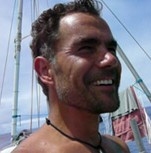Featured Stories | December 10, 2014
A Quarter Million Tons of Plastic Float in Our Oceans, says Dr. Marcus Eriksen
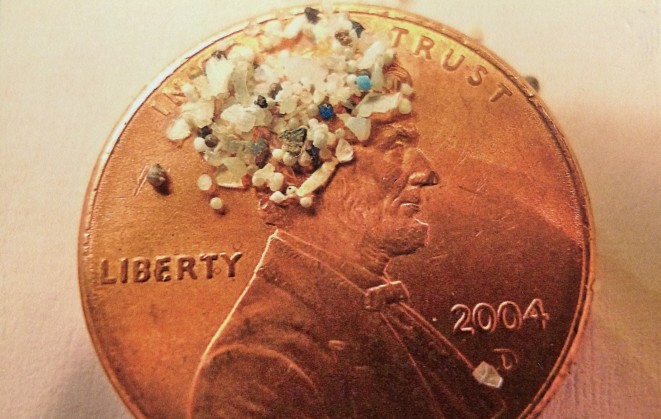
By Genevieve Wanucha
In a paper just published in PLoSOne, Dr. Marcus Eriksen of the 5 Gyres Foundation and colleagues released the first global estimate of all plastics in the surface oceans, based on 5 years of observational work at sea: There are 269,000 metric tons of marine plastic pollution, dispersed in 5.25 trillion particles. You can think about that figure as 38,000 African elephants or drinking straws wrapped around the equator 425 times, or a stack of 2-liter bottles reaching to the moon and back–twice. That’s not counting the plastic micro-particles less than 0.33 mm, sunken plastics, debris washed ashore, or plastics hovering in the water column, which are too difficult to measure.
“That’s a lot of junk,” said Dr. Eriksen, who leads annual ocean research expeditions to study and bring myth-busted awareness to the problem of marine plastic pollution. He decided to devote his life and career to the marine plastic issue after he visited the Midway Atoll in 2000 and saw hundreds of albatross with plastic pouring out of their chests. In 2003, he built a junk raft and floated down the Mississippi River, where he saw a stream of trash everywhere he looked. Eriksen co-founded 5Gryes, an organization devoted to planet free of plastic pollution, which publishes marine research and launches science-based environmental campaigns.
Eriksen visited MIT last week to give a special seminar about his work, hosted by the MIT Graduate Student Council on Sustainability. Oceans at MIT sat down with him for an interview to discuss the scope of the problem, possible solutions, and his science and art.
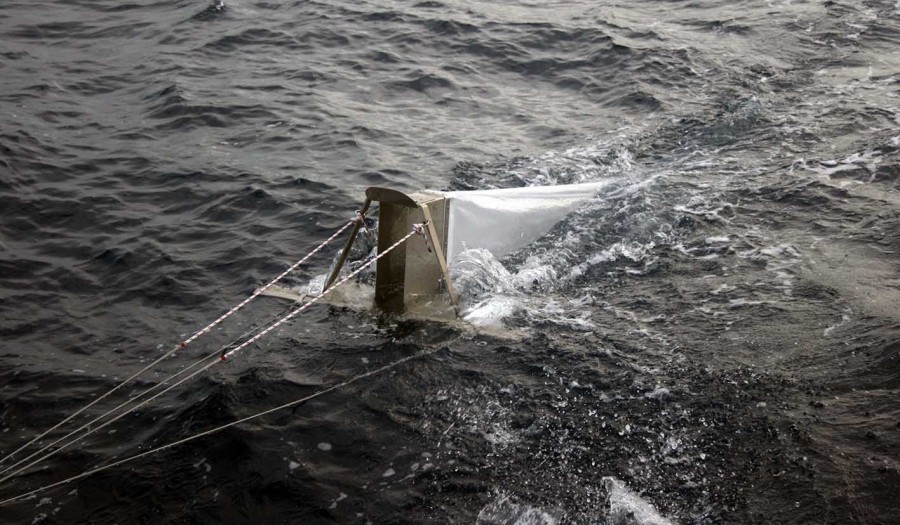
What’s the science behind the first global estimate? Any surprises?
The estimate comes from data collected on our 14 ocean expeditions plus data from my international colleagues. The research involves dragging a “manta trawler” behind the boat, which skims the ocean surface with a net that can trap plastic particles as small as 0.33 mm. We count, weigh, and sort them into size classes that range from rice grain-size pieces to water bottles. We also perform observations where one of us simply stands at the side of the boat with a stopwatch and documents whatever plastic, usually derelict fishing gear, we see bobbing at the surface over an hour.
Our most surprising finding was that we saw far less microplastics (< 1 mm) than we expected based on estimated fragmentation rates, actually, one-hundredth as many particles as our model predicted. The small stuff just isn’t on the surface. Wind driven ocean gyres, where plastics tend to accumulate, are doing something to the plastic we don’t completely understand yet. We suggest in our new paper that ocean gyres act as giant plastic shredders. In gyres, plastic is torn apart by marine life and UV sunlight, and a small amount of biodegradation by microbes occurs. We think microplastics then get ejected by the gyres and transported across the globe by currents and get ingested by marine life.
What are the possible consequences to human health of plastic in the ocean?
In the ocean and lakes, plastic becomes toxic waste. Microplastics become coated with toxins such as PCBs, DDT, persistent organic pollutants, and flame retardants in the water. We’re concerned that fish that consume the microplastics could absorb the chemicals, and pass them along to other animals when they get eaten, which means the toxins could bio-accumulate all up the food chain to your dinner plate. We find microplastics and microfibers in ice cores, zooplankton, and crustaceans.
Considering that the world produces about 288 million tons of plastic each year, and the National Academy of Science estimates that about 0.1% of the world annual production ends up floating in the ocean. How does that plastic get there?
Plastic is a product of civilization. Some call it “the lubrication for globalization” as it moves things across the globe. We all use it, and we all use it. The developing countries with poor waste management are losing the big stuff such as plastic wrappers off their coastlines. Whereas in our communities in US Europe and Australia, we see less the big stuff and more the microplastics. Microplastics are created on land in many ways, such as road abrasion and shredding under UV light. Plastic micro-beads used in some face scrubs and toothpastes, and micro-fibers from washing textiles leach into the environment. Beach cleanups in US and Europe can’t pick up microplastics. Potentially billions of particles a day are leaving American watersheds.
I don’t want to just blame litter. We can’t blame people in India for not recycling when half of the plastic they use is not practical for recycling. We can blame product design. In countries with poor waste management, PET plastic soda bottles are not litter anywhere, they have too much inherent value. If plastic trash has value in India, it’s not on the ground because waste pickers know they can get money for them. But you will see single-use throwaway products such as wrappers, Chai cups, and single-use shampoo packets, which have no value. If products are designed to have value, the problem would be no where near as bad as it is. Design matters as much as individual behavior and recycling infrastructure. If plastic products have no value, recycling is irrelevant.
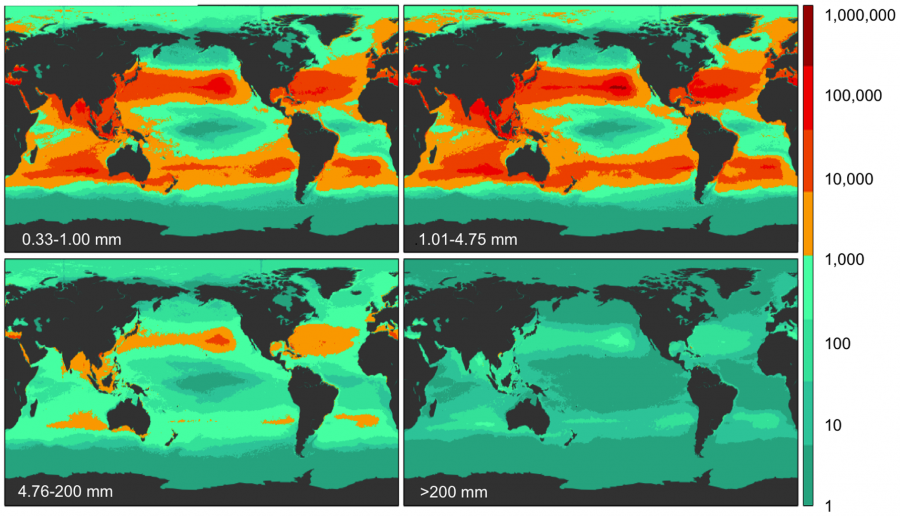
What can we do to solve the marine plastic problem?
I think we have to pass legislation that enforces better recovery systems for plastic products. If a plastic bag was 10 times thicker and made from PET and you wouldn’t see them on the ground—it’s about value for recovery. And that can be subsidized. The plastic industry could say, look we are going to add 10 cents to a pound of raw virgin plastic pellets, and that 10 cents goes to a recovery fund that you as a consumer will get back if you bring back a pound of mixed dry clean plastics. I would also advocate for less styrofoam packaging for food because recycling that material is difficult.
Business need to be responsible for making their products recoverable. We need to urge companies to adopt the Benefit Corporation model, which means a company adheres to a mission statement about creating a positive material impact. For example, Micheal Brown owns the company Packaging 2.0, the first B-Corp in Rhode Island, which makes 100% post-consumer recycled clamshell packaging that’s also easy to recycle. To see that shift happening where corporations are embracing people and planet focused mission statements is wonderful.
Some ideas for scientific contributions are creating a fishing buoy that chemically self destructs in 10 years. Derelict fishing gear is the majority of the weight of plastic pollution in the ocean, designed to last forever, and transport invasive species around. There could be better structural controls, such as the Baltimore water wheel, which pulls trash out of a bend in the stream where trash collects.
What do you think has been the impact of all your work over the past decade?
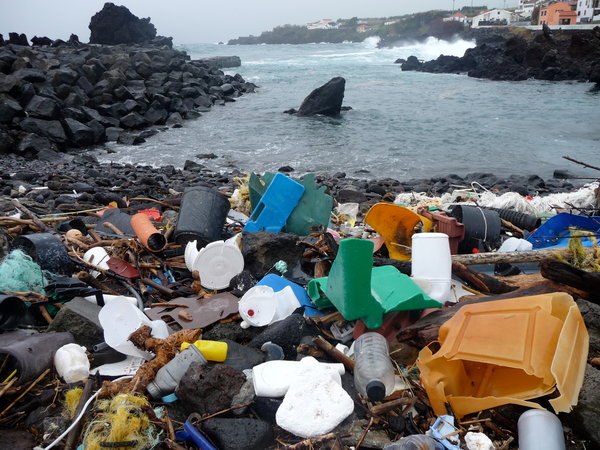
Every expedition, we rent an available vessel and, to fund the trip, we sell the seats to scientists, artists, policy makers, educators, and CEOs of companies who all want to see the problem for themselves and help become part of the solution. I think our work has helped to keep the conversation about marine plastic pollution alive.
Now, we are seeing different cultures embrace the marine plastic issue. Europe has taken the lead in research and has mandated that member nations monitor the coastlines for plastics. In the US, we are seeing more and more attention to plastic bags, foam polystyrene, and micro-beads. We performed the first ever survey for plastic pollution in the Great Lakes with Dr. Sherri Mason from SUNY Fredonia, and we discovered pollution from plastic micro-beads that are used in some face scrubs and toothpastes. We published a paper last November, and within 6 months, there were debates on the senate floor in the Illinois, California, and New York about banning micro-beads in products. Now, several companies have pledged to discontinue using micro-beads. That’s how we take published research and turn it into science-based campaigns that are ultimately good for our society.
We also myth-bust. When the plastic pollution issue first entered public awareness, the mainstream media sensationalized the issue so dramatically and badly. To say there is a Texas-sized island of trash in the Pacific Ocean is nonsense, and it sparked all these misguided innovations for mechanisms to clean up trash in the ocean, such as a 1-kilometer array of moorings and booms that got 2 million dollars in crowd funding. Going into the ocean with big machines is not a good use of resources because the plastic is fragmenting into little peices and dispersing across 2/3 of the planet’s surface. Maybe you will capture fishing buoys and derelict fishing nets, but you won’t get the microplastics. I would like to think that giving this number of how much trash is out there can help us make some smart decisions about what should be done. Let’s get a better handle on front-end solutions–better product design or systems of recovery that work.
There are also some intentional myths around “bioplastics,” such as Coca Cola’s PlantBottle™ made from “30% plants.” That’s just using 30% modern plants to make the same polymer that fossil fuels are used to make, with the exact same ocean impact. But put a leaf on it, and it sells.
Have you received any response from the plastic industry?
The coalition Save the Plastic Bag does not like what we do. They receive funding from the American Chemistry Council, a trade organization that fights for interests of the plastic industry. When 5 Gyres displayed part of the original junk raft on the California State House steps in 2009, ACC representatives dressed in black circled the raft and pulled reporters aside to talk about opportunities for recycling. They fight all legislation to ban micro-beads, plastic bags, foam, and anything that stops production of plastics regardless if it’s the right thing to do for people and planet.
You have created art exhibits ‘Saving our Synthetic Seas’ and ‘Junk and Gyre.’ Why do you add an artistic aspect to your work?
Our traveling exhibits display eclectic pieces, such as my first junk raft, a surf board covered in cigarette lighters found inside bird skeletons, a tangled mass of plastic bags from a camel’s stomach, plastic face casts of ocean explorers Sylvia Earle, Charles Moore, and Hideshige Takada, and my wife’s pregnant body cast in melted plastic bits from around the world, for example. I find art work to be a very strong communicator. See, I enjoy working with scientists but I realize they are not always the best communicators. With the current environmental problems and expanding population, we scientists can’t do our work in a vacuum publish in journals and walk away. I feel that scientists have an obligation to make sure that research has an impact.
We’ll leave you with a video made to coincide with the paper’s release:

